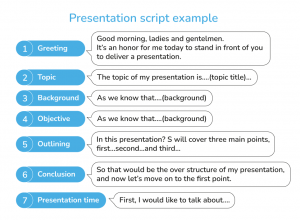
Crafting a presentation goes beyond simply putting together content. It also involves mastering the art of scripting by the speaker. Learning how to write a script for a presentation can take some time and effort to master, and similar to designing Google slides or PowerPoint presentations, there are several important rules to follow.
From developing a compelling storyboard and adding strategic pauses to making sure the words match the slides and maintaining a natural flow, delivering an effective presentation speech is a skill that needs to be honed.
In this article, we aim to provide comprehensive guidance on all these aspects and more, making it easier for you to create a presentation script that effortlessly resonates with your audience.
When it comes to crafting presentation scripts, planning is vital. A speaker must be well-prepared and have ample time before the event to practice and make sure the content flows naturally. Therefore, clear storyboarding must come first if you want to produce excellent presentation content. This is particularly true when the script and design are being done by the same person.
‘KISS,’ or Keep It Short and Simple, is the number one rule for crafting a fantastic script for presentation. Short and concise sentences can help you get the message across much faster, especially if your presentation’s emphasis is placed more on the visuals than the aural aspect.
A strong introduction is critical to captivate the audience’s attention and make them interested in what you have to say. This can be done through a compelling narrative, a thought-provoking question, or a startling fact. Remember, your introduction for presentation script should be designed to hook the audience and make them want to keep listening.
The presentation script’s content needs to be well-organized and structured. It has to have natural transitions from one idea to another, as well as distinct breaks between sections. And to make each argument more convincing and relatable to the audience, you should back it up with examples or evidence.
It’s important to keep in mind that the information on your slides must serve as the basis for your script. It should be closely related to the presentation material you have already storyboarded and be simple to follow.
In case your script for PowerPoint presentation doesn’t match the content on the slides, the audience will likely feel confused and lose their place. That’s why it is recommended that you always have the presentation’s material nearby. Divide the text into chunks corresponding to the slides’ arrangement so that the two complement one another perfectly.
Make your next ppt a successReach your goals with a pro team that will consult, research, write content, and create wow slides for you.
When attending a presentation, an audience member has two tasks: first, taking in the speaker’s words, and second, understanding the information offered by the presentation content. Therefore, when writing a script for a presentation, it’s essential that you always put yourself in the audience’s shoes and include pauses in the script.
Remember, when the speaker pauses, the audience has a chance to digest what has just been said and absorb as much information as possible from the visual aids. Additionally, it gives you, as a speaker, more control over the audience’s attention during the entire speech.
Whether it’s an introduction for presentation script or a closing part, your entire content should be written in clear and engaging language. Refrain from using technical or jargon terminology that the audience might not understand. Instead, speak in plain English and incorporate jokes, rhetorical questions, or storytelling to keep the audience interested throughout your presentation.
Strong presentation scripts always end with a clear call to action. This could be requesting that the audience takes a specific action, such as subscribing to a newsletter, making a purchase, or putting the concepts discussed into practice in their own lives or places of employment. Your call to action must be captivating and inspire the audience to do the desired action.
Practice and rehearsal are essential components of a good script. That’s why it is crucial to rehearse your script several times, ensuring a smooth delivery. Additionally, practice helps boost self-assurance and ease presentation-day nervousness.
By including these components in your PowerPoint presentation script, you can create a persuasive and memorable presentation that effectively conveys your message and interests your audience.
Writing down every word you intend to say might sometimes result in overly scripted content, which can lack empathy and prevent you from connecting with the audience. Therefore, sometimes it is enough to simply focus on the key points or even use slide content as a starting point, keeping in mind the presentation’s structure and your time limit.
Now that you know how to write a presentation script, let’s look at some examples to see the above tips in practice.
Detailed presentation script:
Presentation script containing only key points:
All in all, having a presentation script is essential for delivering a great audience experience. It gives you flow, structure, and two times more confidence than when you are simply improvising or reading off your slides.
Use the above guidelines to ensure you are starting with a strong script, and remember that our presentation design company is here to help 24/7! SlidePeak’s dedicated team can not only help you improve your old presentation but can also design a professional pitch deck with unique infographics to wow potential investors, clients, and employers.